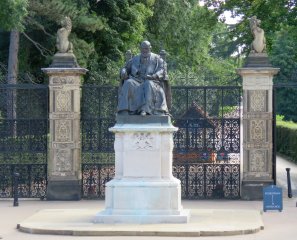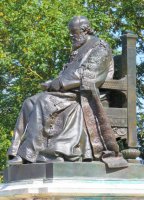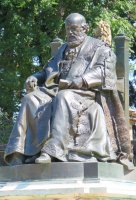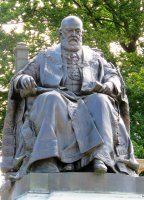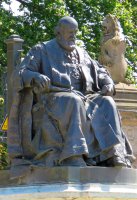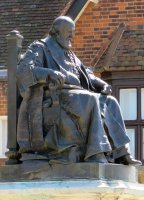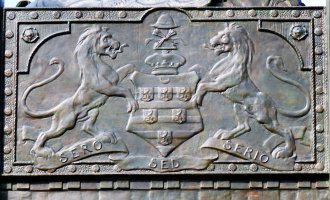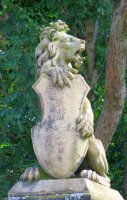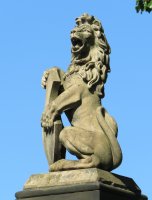Statue of 3rd Marquess of Salisbury, Hatfield, by George Frampton
The bronze statue of Robert Gascoyne-Cecil, third Marquess of Salisbury, in Hatfield, Hertfordshire, is an excellent example of portrait sculpture by the important sculptor George Frampton.
The statue of Robert Arthur Talbot Gascoyne-Cecil, third Marquess of Salisbury and Prime Minister, unveiled in 1906, is situated by the gate to the north side of his family seat, Hatfield House, Hertfordshire - it is directly on the route from the railway station to Hatfield House. The Marquess is seated, shoulders leaning somewhat forward from his grand chair, one hand holding the armrest, the other arm with elbow on the other armrest, and the hand a folded scroll or sheaf of papers. His bulky figure is given further mass by being enveloped in a robe, richly decorated with heraldic devices and with long sides to the sleeves, - it is his ceremonial robe as Chancellor of Oxford University - and he wears too the insignia of the Order of the Garter.
3rd Marquess of Salisbury, various views.
The statue is on a stone plinth – well over the height of a tall man and wide to accommodate the seated rather than standing statue, with his arms carved on the front, and the inscription: Robert Arthur Talbot, Marquess of Salisbury, KG CCVO, Three times Prime Minister of Great Britain and Ireland, 1850-1903.’ And below that on a projecting lower part: ‘Erected to his memory by his Hertfordshire friends and neighbours in recognition of a great life devoted to the welfare of his country’. Today, he is perhaps most remembered for being Prime Minister three times and for his policy of ‘splendid isolation’ from Europe, which has a degree of relevance today. His descent is from Robert Cecil, first Earl of Salisbury, and the 7th Earl moved up a rank to become the first Marquess of Salisbury, thus grandfather of our man.
Coat of arms, on rear of monument.
I like this statue for its sheer grandeur: the physical bulk, the sense of presence, and yet this commanding figure is looking down, more in thought than with piercing gaze, so feeling approachable, human, a little careworn with the duties of office perhaps. The composition, leaning slightly forward, and slightly to the right from the viewer’s perspective, gives a sense of movement even to the seated figure, and the broad folds of his robe gives a nice play of light over the legs, and deep pockets of darkness over the chest and arms.
The sculptor was George Frampton, who is at his best with ideal female figures – the fantastical symbolist Lamia and Mysteriarch, the allegorical figures on the spandrels above the entrance to the V&A (see this page) and on the front of Lloyds Registry, the youthful elves on the Peter Pan monument (see this page) – but was also highly successful with portrait sculpture. He did rather like broad robes on his figures, and his statues of Major Lester and William Rathbone in Liverpool (see this page), and Queen Victoria in Leeds are examples of variations on the theme by him. More on George Frampton on this page.
Heraldic lions from gate behind statue.
The Marchioness was buried in the close by Church of St Etheldreda, wherein is a recumbent bronze figure of him, by William Goscombe John, along with many other good sculptural things.
